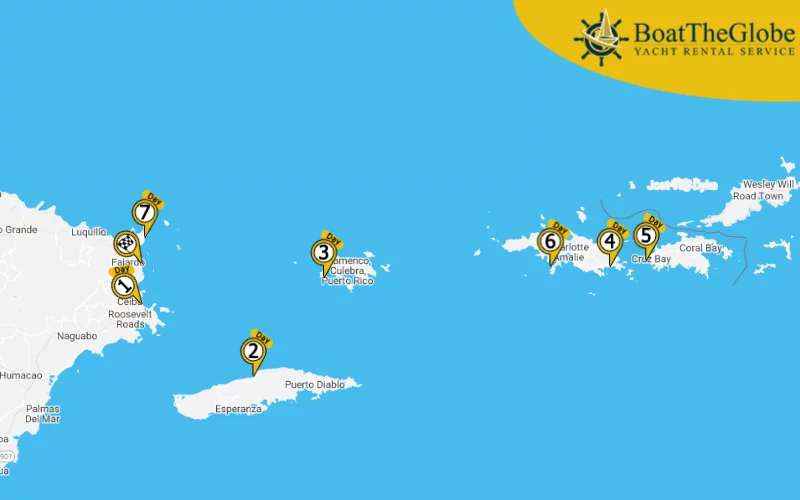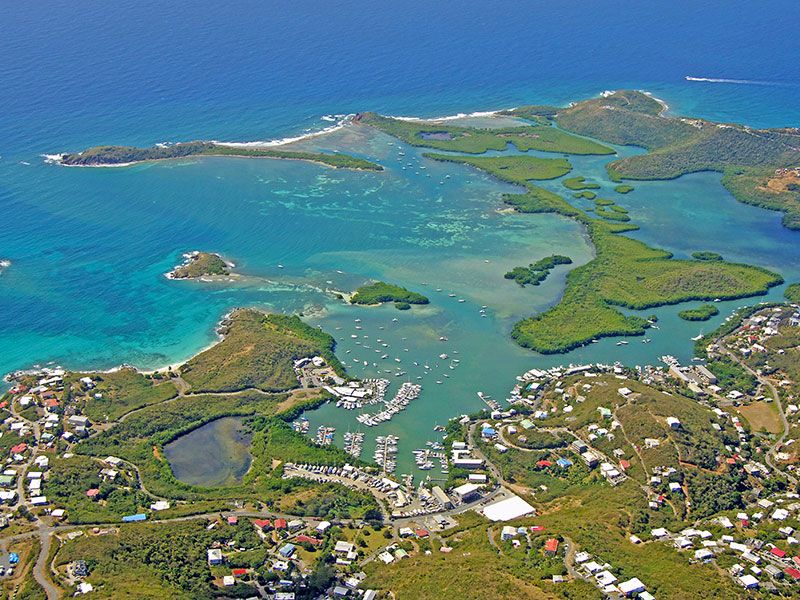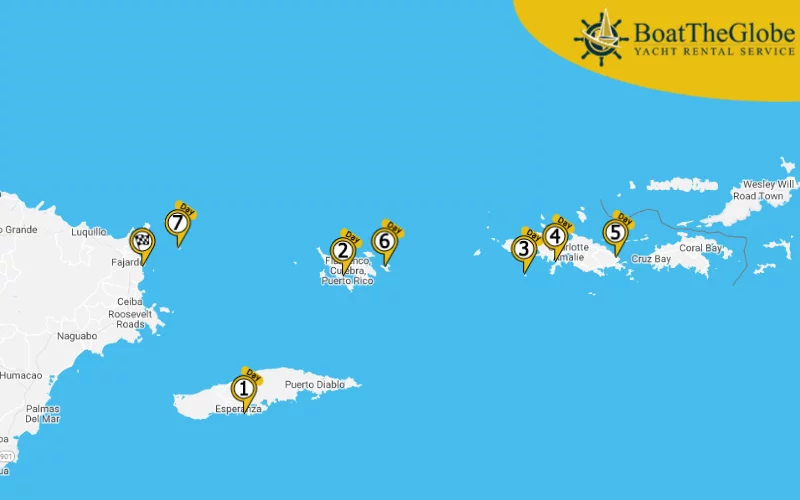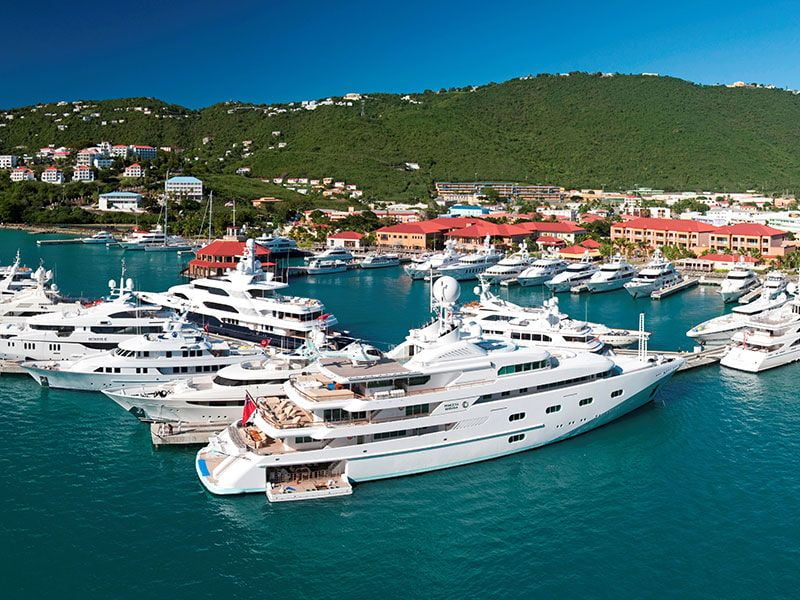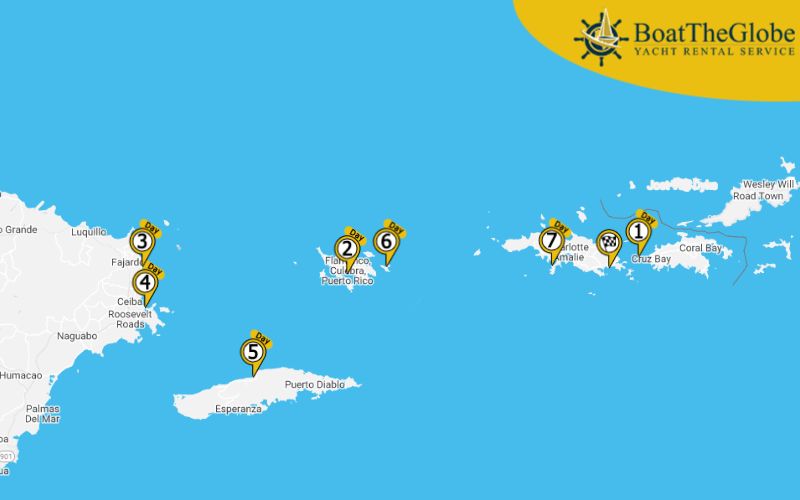Are you planning a sailing tour from St Thomas to Puerto Rico, or Puerto Rico to USVI? If we go towards the east from Puerto Rico, we can sail to the gorgeous United States Virgin Islands and Saint Thomas. In this area, we can choose from countless route variations. If we are looking for relaxing recreation, we can get to amazing places even on short-distance trips; however, if we prefer exciting adventures full of challenges, we will also find a perfect route. This article is intended for those who are planning a trip from Puerto Rico to St. Thomas by their own boat or a rented yacht.
In this article, we will give you a summary of the following topics:
- Important information if you sail from St Thomas to Puerto Rico
- What’s worth knowing about Saint Thomas?
- Magnificent islands en route to and around Saint Thomas
- Ports between Puerto Rico and Saint Thomas
- Sailing routes from Puerto Rico to St Thomas, or from St. Thomas to Puerto Rico
- Marine gas around Puerto Rico, boat gas stations near Saint Thomas
Important information if you sail from St Thomas to Puerto Rico
Puerto Rico is surrounded by the Atlantic Ocean and the Caribbean Sea, and there are four islands located nearby: Vieques, Culebra, Mona Desecheo, and Caja de Muertos. Only Vieques and Culebra have a resident population. The country is among the unincorporated territories of the United States – this is an important piece of information that we should bear in mind when obtaining the documents required to enter. The official languages are English and Spanish, and their currency is the US Dollar.
Climate
Being a tropical area, the average temperature in Puerto Rico is 28° Celsius. The weather does not change drastically; the warmest month is June, but the average temperature is around 24° Celsius even in the coldest month, January. When planning our journey, we should definitely calculate the hurricane season, which is typical in the area. This period is between August and October. If we are planning to go sailing during this time, we need to be extremely careful and cautious; the trip is definitely not recommended for beginners. The trade winds are present in the area – this means that the air moves continuously in one direction for a specific amount of time.
The dominant wind coming from the northeast is present from January to March; during the rest of the year, it is blowing in the east around October. The northeastern wind has a velocity of 28–35 km/h. When it calms down, its velocity is reduced to 18–28 km/h. The mildest air movement is present in September and October. The so-called Christmas Wind is the strongest wind – its velocity may even reach 45–55 km/h. This period can take as long as weeks. The winds that are constantly present in the area make it easier to bear the hot weather on the boat, but it is still recommended to protect our skin from the sun. You should prepare with the proper types of clothes and make sure that you drink enough water and stay hydrated. Check the sailing conditions and wind rose diagram of Puerto Rico, or sailing conditions and wind rose diagram of Virgin islands.
Traveling To Puerto Rico
There are many well-maintained berths, docks and yacht clubs all over the country and on the eastern islands, and we can also find ports with free berths. Thanks to the local organizations (US Coast Guard, Puerto Rican Marine Police, Federal Park Rangers) they have excellent public safety; there is practically no boat theft or aggression on the streets.
The country has several airports; the largest one is the San Juan International Airport in the capital. We can rent a car almost everywhere and even with the “One-way car” option, and we can also use the public car system.
What’s worth knowing about Saint Thomas?
Saint Thomas belongs to the United States Virgin Islands, so they are among the outlying territories of the US. Due to its great beaches and vibrant nightlife, it is the most popular island in the area and also one of the most developed lands in terms of sailing and tourism. In Saint Thomas, there are many excellent ports that visitors can choose from. Charlotte Amelia – the capital – has many shops, restaurants, and bars offering local products, spices, gems, drinks, and handcrafted items. There are several beautiful shores to discover nearby, including scuba-diving spots and beaches.
Magnificent islands en route to and around Saint Thomas
The capital of Saint Thomas is located 80 kilometres from the eastern shores of Puerto Rico. We can find many beautiful islands in this destination where we can anchor and spend a day. Examples include Culebra and Vieques, the Unites States Virgin Islands, and Jost van Dyke.
Culebra
Culebra is a true gem of Puerto Rico. It is surrounded by beautifully clear water, there are many berths and the coral reef is full of life. One of the most beautiful ports here is the Ensenada Honda Bay. This is the largest local docking place which is also an ecotourism centre. The bay is protected from all directions, and the boats can be secured easily – the sea bottom is mostly sandy and will hold the vessels firmly.
Vieques
We can find many great ports on the island of Vieques as well, especially on the southern coast. This is a very exciting place for several reasons. Sailors used to bypass the area as the American military forces held firearms training here. Of course, they have ceased their activity in the area since then, so it’s completely safe. Most of the island is a natural preserve. We can benefit from the good-quality berths offered here for free. The capital is Isabella Segunda. We can get everything we may need here from fuel to food and drinks. The most interesting sight on the island is Mosquito Bay, which is a bioluminescent bay literally illuminated during the nights. It is a special and breathtaking natural phenomenon occurring at night, which may remind us of the waves of a magical sea. Local beaches are protected, peaceful and if we are lucky, we can even admire the famous rainbow-like starfish in Vieques, too!
Saint John
If you are looking for an unspoiled natural experience in a quieter environment, you should sail to Saint John. With its beautiful coral reef and exciting hiking routes, it is one of the pioneers in Caribbean ecotourism; we can also access other smaller islands from here including the island of Jost Van Dyke, Tortola, Norman Island, Virgin Gorda, and Water Island.
Water Island
The volcanic island is located south of Saint Thomas, not far from Charlotte Amelie. Water Island is the smallest island of the United States Virgin Islands with a territory of only 200 hectares. It is worth visiting this place if we want to relax, enjoy the beach or go fishing. But if we prefer wandering around, we can take a walk on Limestone Beach or explore the remains of the old military fort Fort Segarra.
Hans Lollik Islands
The two smaller islands called Hans Lollik also belong to the United States Virgin Islands. The larger island (Great Hans Lollik) can be found in the app. 3 kilometres from the northern coast of Saint Thomas; the two are separated by the Leeward Passage. Visitors will see a breathtaking sight here: beautiful blue water, palm forest, and rocks emerging from the sea. Thanks to its unspoiled nature, it is an ideal habitat for all types of coral.
Jost Van Dyke
Jost van Dyke is located app. 20 kilometres from the eastern shores of Saint Thomas, but it belongs to the British Virgin Islands. Similarly to the islands located nearby, this one is also volcanic. It is a very popular destination among sailors – its most famous port is the Great Harbor, which is also one of the busiest docks of the archipelago. The other significant port, Little Harbor is a beautiful and quiet dock with app. 20 buoys altogether. It can be easily accessed through Garner Bay, but the water is fairly shallow on both sides. On the northern coast, the depth of water varies between 4.5 and 9 metres. On the northeastern coast, at the edge of the bay is Little Harbor Marina where we can refuel our boat and replenish our water and ice supplies.
Ports between Puerto Rico and Saint Thomas
There are several yacht ports on the island of Saint Thomas, especially on the southern and eastern shores. On the north, there are mostly beaches. Being a naval centre, most docks are well-equipped and offer full service. Rent a boat in Puerto Rico and experience what it feels like when everything is perfectly timed – the sunset, the sea, and freedom.
Yacht Haven Grande
(18°20’15.5″N 64°55’07.4″W)
Yacht Haven Grande is a smaller port in the eastern part of Charlotte Amalie with 48 berths and with a maximum length of 200 metres and a depth of 7.5 metres. We can navigate through Charlotte Amalie Bay to enter. They have a full service and provide in-slip fuelling as well. If we would like to spend some time in the neighbourhood, we can choose from several shops and restaurants.
American Yacht Harbor
(18°19’31.5″N 64°51’06.4″W)
The American Yacht Harbor is located in Red Hook, Saint Thomas, and can be accessed by navigating into Vessup Bay. There are 123 docks established here with a maximum allowable length of 36 metres and a depth of 3 metres for boats. This is also a full-service port with high-speed fuel pumps and boat maintenance. There is a large supermarket in the village nearby.
Crown Bay Marina
(18° 19′ 59″ N / 064° 57′ 05″ W)
Crown Bay Marina can be found in the western part of Charlotte Amalie, on the southern coast of the island. We can navigate through the West Gregorie channel. There are nearly 100 established docking places and a 96-meter-long fuel dock here; they offer fair prices, too. The depth of the pool is 6 metres; it is well-visible and free of any obstructions. If we need help with docking, we can ask the trained staff. There is a sailing shop and we will also find restaurants, cafés and a post office here; they provide Wi-Fi and electricity. It is worth mentioning that Crown Bay Marina is fairly busy – boats of all sizes and types dock here.
Sapphire Beach Marina
(18°20’04.9″N 64°50’56.3″W)
This port is located in the eastern corner of Saint Thomas. Docks are 15 metres long and 5.5 metres wide. The depth of water is 3 metres. They also provide a laundry service as well as electricity. Thanks to its small size, this port is much more peaceful than the average ones.
National Park Service Dock
(18°19’29.6″N 64°50’57.6″W)
The National Park Service Dock can also be found in the east, in Vessup Bay. It is easily accessible and free of any obstructions. If we want to explore the amazing and diverse wildlife of the Virgin Islands, we should visit the national park in Saint John app. 5 kilometres from here. US Virgin Islands sailing
Saga Haven
(18°19’7.27”N 64°52’9.63”W)
Saga Haven is located in the southeastern part of the island; we can access it through Benner Bay. They have berths for 50 boats with 15 metres long and 23 metres wide docks. They provide electricity at each berth. There are two large fuel docks both for boats using gasoline and diesel fuel.
Sailing routes from Puerto Rico to St Thomas, or from St. Thomas to Puerto Rico
Sailing between the two ends is very popular with both departure points. Due to better accessibility and a larger selection of boats, we recommend rent a yacht in St Thomas. As a departure point in Puerto Rico, choose Fajardo, located at the easternmost point of Puerto Rico. The city is home to more than five docks. Puerto Del Rey is one of the largest ports in the Caribbean and can accommodate a thousand yachts with excellent conditions. We depart from the US Virgin Islands from the port of the capital, Charlotte Amelie, near the airport. From here, several airlines operate direct flights to Puerto Rico and the trip is only forty minutes. It is important to take into account the prevailing winds in the area when making your decision, as winds from the wrong direction can make things difficult on the way there or back.
7 days long one-way catamaran trip from Fajardo to Saint Thomas
Day 1. Fajardo – Ceiba
5.00 km (3.10 nm)
On the first day, we will stay close to Puerto Rico and head towards Ceiba. The city can be found on the northeastern coast of the city, and it got its name from its rich ceiba (kapok) forest. It is surrounded by the Atlantic Ocean and the Rio Grande; its capital, San Juan can be reached in one hour. We can dock just west of the docks where the sea bottom is soft and muddy.
Day 2. Ceiba – Vieques (Bahía Icacos)
35.45 km (22.03 nm)
Bahia Icacos is located on the eastern coast of Vieques. This part of the island is less crowded than the others. The entrance to the bay is surrounded by a coral reef, but we can easily spot it in the beautiful, clear water. Docking should not be a problem with an experienced skipper, especially if the wind is favourable.
Day 3. Bahía Icacos – Cayo Luis Pena
18.35 km (11.40 nm)
The tiny and peaceful island Cayo Luis belongs to Culebra. There are two mooring buoys on the island altogether, but we can go ahead and tie our boat to them without any problem. This place is mainly for those looking for peace and quiet, but sometimes that’s all we really need.
Day 4. Cayo Luis Pena – Benner Bay (Saint Thomas)
56.25 km (34.95 nm)
Benner Bay is a 12-kilometer-long passage located east of Saint Thomas. There is a smaller archipelago in the bay (Cas Cay, Rotts Cay, and Grassy Cay). First, we will encounter Cas Cay and Patricia Cay, but it’s important to note that we shouldn’t navigate through the two, as this is not the entrance to the bay. We will need to navigate through Jersey Bay – slightly further to the east – with Rotto Cay on our right-hand side. We should just follow the channel leading into the bay afterwards, and dock at one of the marinas there. Compass Point Marina is located a bit further, and the Independent Boat Yard Marina can be found all the way down to the inner part of the bay.
Day 5. Benner Bay – Saint John (Cruz Bay)
8.90 km (5.53 nm)
Cruz Bay leads us to the entrance of Saint John and the western part of the island. This is the commercial centre of the area which is very popular among tourists. We can find boat stops at most bays, and if we have some spare time and feel like exploring, we can visit the Virgin Islands National Park.
Day 6. Cruz Bay – Druif Bay (Honeymoon Bay)
20.80 km (12.93 nm)
Druif Bay is located in the southern part of Saint Thomas, near the West Gregerie channel. The beach is covered with coconut trees, and it is an ideal spot for relaxation. They have great docking places in the northeastern corner of the bay, but they are fairly crowded during the day.
Day 7. Druif Bay – Las Croabas – Fajardo
70.35 km (43.71 nm)
App. 5 kilometres from Fajardo, we can find a narrow bay with a peaceful little town. This it Las Croabas. Interestingly, there is a “DIY” dockyard here – we have the opportunity to fix up our boat on the small courtyard. The only limit of the port is the depth of water – unfortunately, it is very shallow, but we still have other opportunities outside the dock to secure our boat. If we find the trip too long, we can also stop at Culebra or Culebrita.
7 days long catamaran sailing from Puerto Rico to Saint Thomas
Day 1. Fajardo (Puerto del Rey) – Vieques (Esperanza)
40.25 km (25.01 nm)
Esperanza is one of the two towns located on the island. It can be found on the southern coast, and is very popular among tourists thanks to its cosy restaurants, boutiques, and boardwalk. We can explore dozens of spots here where we can relax and have a beer or a coffee while admiring the bay. The locals are very nice and hospitable. We can dock at any ports in town, as they are all excellent. It’s important to note that the water passage north of Cayo Real is very narrow – if we have a chance, we should use another passage to navigate through.
Day 2. Esperanza – Culebra (Dewey Habor)
17.50 km (10.87 nm)
The island Culebra not only attracts sailing enthusiasts – but it is also a tiny Eden for those who love swimming. The reason is that Flamenco Beach, considered one of the most beautiful beaches in the entire world, can be found here. We can visit several other beaches as well – there are 9 of them on the island overall.
The town we have arrived at is Dewey, referred to as Culebra by the locals, similarly to the island itself. There are quite a lot of docks in the bay. We can get water and refuel our boat here. If we are hungry, there are many nice restaurants along the shores to choose from.
Day 3. Dewey Harbor – Saba Island (Port Bay Harbor)
31.80 km (19.76 nm)
This tiny island with its territory of only 12 square kilometres is a unique municipality belonging to the Netherlands, and there are only 4 towns here. Similarly to other Caribbean areas, this island has not been affected by today’s busy and hectic world. There is one single port, Port Bay Harbor – it is well-equipped and we can arrange everything we need here.
Day 4. Saba Island – Saint Thomas (Yacht Haven Grande)
9.00 km (5.60 nm)
When approaching Saint Thomas, we will feel like the island is “swimming into” the sea. We should definitely head to the capital, Charlotte Amelie first. The waters surrounding the Virgin Islands can easily be accessed from Yacht Haven Grande. The dock can be reached on foot from the historic downtown of Charlotte Amalie, and we can also find one of the most beautiful beaches, Magen’s Bay in the area here.
Day 5. Yacht Haven Grande (Charlotte Amelie) –Sapphire Beach (Red Hook)
14.00 km (8, .0 nm)
Sapphire Beach is located app. 5 minutes from Red Hook. We can explore the marvellous coral reef and the beautiful white sandy beaches nearby. There are dozens of fascinating restaurants and shops on Marina Market offering an imposing view. It is a perfect place to get acquainted with Saint Thomas better. The area is well-known for its beautiful beaches such as Nazareth Bay with its protected waters.
Day 6. – Red Hook – Culebrita
50 km (31.1 nm)
Culebrita is the “little brother” of Culebra. It is a natural preserve with its long coral island, and it belongs to the Culebra National Wildlife Refuge. This is where one of the country’s oldest lighthouse is located – it provides a fantastic view in good weather. For relaxing, we recommend the Tortuga, which is named after the island’s native tortoise.
Day 7. Culebrita – Isla Palomino – Fajardo
37.20 km (23.12 nm)
Palomino, a tiny and uninhabited private island can be found the app. 5 kilometres from the shores of Fajardo. There is a good docking spot just south of the island, directly behind the coral reef of the island of Palominos. We can admire amazing white sandy beaches, the coral reef, and several species of animals or we can get a taste of the Caribbean luxury. We can relax and have a cocktail while enjoying the turquoise water surrounding us.
Sailing from Saint Thomas to Puerto Rico
Day 1. Saint Thomas – Cruz Bay 8,67 km (5,39 nm), Day 2. Cruz Bay – Culebra 55,01 km (34,18 nm), Day 3. Culebra – Fajardo 43,75 km (27,18 nm), Day 4. Fajardo – Ceiba 7,70 km (4,78 nm), Day 5. Ceiba – Vieques 24,48 km (15,21 nm), Day 6. Vieques – Playa Tortuga 32,16 km (19,99 nm), Day 7. Playa Tortuga – Druif Bay – Saint Thomas 40,18 km (24,97 nm)
Marine gas around Puerto Rico, boat gas stations near Saint Thomas
- GUAYANILLA: Depth: 9.14 m, Working time: 9-19, GPS Coordinates:17°59′52.00″N 66°45′55.00″W
- MAYAGUEZ: Depth: 11-12 m, Working time: 08-20, GPS Coordinates: 18°12′50.00″N 67°9′39.00″W
- PONCE: Depth: 7.1m – 9.1 m, Working time: 6-22, GPS Coordinates: 18°0′0.00″N 66°36′58.00″W
- SAN JUAN: Depth: 9.4 -10 m, Working time: 6-24, GPS Coordinates: 18°27′27.97″N 66°5′57.28″W
- YABUCOA: Depth: 14-15 m, Working time: 9-19, GPS Coordinates: 18°2′51.44″N 65°49′24.18″W
Marine gas near Saint Thomas
- CROWN BAY MARINA: Depth: 10 m, Working time: 8-15, GPS Coordinates:18° 20′ 24″N 64° 57′ 24″W
- YACHT HAVEN GRANDE: Depth: 7, 6 m, Working time: 7:30-18:00, GPS Coordinates: 18.501159, -64.932187
- COMPASS POINT MARINA: Depth: 7.1m – 9.1 m, Working time: 8-18, GPS Coordinates: 18.318584442138672, -64.86392974853516
If we choose Puerto Rico and Saint Thomas as the destination for our next sailing trip, we can choose from countless opportunities. We can sail to an island of the Virgin Islands, and if we like spending time on the land as well, there are many sights to see here. Regardless of whether we stay here for only a few days or weeks – maybe even months – we will definitely not be bored. There are dozens of treasures to explore while spending time away from our hectic world; we can get a real taste of hot tropical life. It doesn’t matter what your destination is – you will definitely find what your heart wants.
Imagine this: Puerto Rico, endless blue waters, and all you have to do is enjoy it. The finding of the ideal yacht? Local rules? Consider them taken care of. Just fill out the form below, request your quote, step aboard your yacht, and let your unforgettable journey begin. Simple as that.





